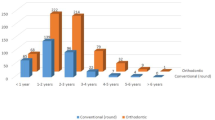Summary
PURPOSE: Reverse chewing cycles are dyskinetic masticatory pattern highly represented in crossbite patients. The aim of this study was to analyze the prevalence of reverse-sequencing chewing cycles in a family (41-year-old father, 41-year-old mother, 10.8-year-old daughter, 7-year-old son), affected by crossbite, to evaluate the functional aspects of an inherited malocclusion. Material and methods: All the family components underwent orthodontic evaluation and chewing cycles recorded with a Myotronics K6-1 kinesiograph. RESULTS: The results showed that the father, who previously corrected a right posterior crossbite, did not develop reverse chewing cycles (0% on the right side and 0% on the left side). The mother and the boy, affected by a bilateral posterior symmetric crossbite, developed significant reverse chewing cycles on both sides (89% on the right side, 75% on the left side, the mother and 70% on the right side, 90% on the left side, the boy); the girl, affected by a bilateral posterior crossbite with a greater number of teeth in crossbite on the left side, developed significant reverse chewing cycles on the left side only (5% on the right side and 100% on the left side). CONCLUSION: The prevalence of the reverse chewing cycles resulted in agreement with the crossbite, mirroring the dental characteristics. These results suggest that not only the bone structure and the dental assessment, but also the function might be inherited. As a consequence, the evaluation of the family history might be an important diagnostic data to early intercept the malocclusion.
Similar content being viewed by others
References
Ben-Bassat Y, Yaffe A, Brin I, Freeman J, Ehrlich Y. Functional and morphological occlusal aspects in children treated for unilateral posterior cross-bite. Eur J Orthod 1993;15:57–63
Björk A, Krebs A, Solow B. A method for epidemiological registration of malocclusion. Acta Odontologica Scan 1964;22:27–41
Bracco P, Deregibus A, Vercellino V. Analisi comparata con l'ausilio del computer. I parte: classificazione basale e posizionamento antero-posteriore delle basi. Mondo Ortod 1981;6:26–39
Brin I, Ben-Bassat Y, Blustein Y, Ehrlich J, Hochman N, Marmary Y, Yaffe A. Skeletal and functional effects of treatment for unilateral posterior crossbite. Am J Orthod Dentofacial Orthop 1996;109:173–9
Castroflorio T, Farina D, Bottin A, Piancino MG, Bracco P, Merletti R. Surface EMG of jaw elevator muscles: effect of electrode location and inter-electrode distance. J Oral Rehabil 2005;32:411–7
da Silva Filho OG, Santamaria M Jr, Capelozza Filho L. Epidemiology of posterior crossbite in the primary dentition. J Clin Pediatr Dent 2007;32:73–8
Lewin A. Electrognathographics: atlas of diagnostic procedures and interpretation. Quintessence Publishing Co. Inc., Berlin 1985:82–5
Nerder PH, Bakke M, Solow B. The functional shift of the mandible in unilateral posterior crossbite and the adaptation of the temporomandibular joints: a pilot study. Eur J Orthod 1999;21:155–66
Piancino MG, Farina D, Merlo A, Greco M, Aprato M, Bracco P. Early tratment with "function generating bite" of a left unilateral posterior cross-bite: chewing pattern before and after therapy with FGB. Int J Orthod Milwaukee 2007;18:33–8
Piancino MG, Talpone F, Dalmasso P, Debernardi C, Lewin A, Bracco P. Reverse-sequencing chewing patterns before and after treatment of children with unilateral posterior crossbite. Eur J Orthod 2006;28:480–4
Piancino MG, Talpone F, Mattioda F, Servo C, Tealdi E, Garrone B, Bracco P. Bilateral posterior crossbite: a case report with chewing cycles before and after orthodontic treatment with function generating bite. Mondo Ortod 2006;3:203–14
Piancino MG, Talpone F, Bole T, Reverdito M, Debernardi C, Bracco P. Chewing pattern before and after unilateral posterior crossbite therapy with function generating bite: a case report. Prog Orthod 2007;8:74–86
Piancino MG, Farina D, Talpone F, Merlo A, Bracco P. Muscular activation during reverse and non-reverse chewing cycles in unilateral posterior crossbite. Eur J Oral Sci 2009;117:122–8
Pinto AS, Buschang PH, Throckmorton GS, Chen P. Morphological and positional asymmetries of young children with functional unilateral posterior crossbite. Am J Orthod Dentofacial Orthop 2001;120:513–20
Santos Pinto A, Buschang PH, Throckmorton GS, Chen P. Morphological and positional asymmetries of young children with functional unilateral posterior crossbite. Am J Orthod Dentofacial Orthop 2001;120:513–20
Saitoh I, Hayasaki H, Iwase Y, Nakata M. Improvement of jaw motion following treatment of unilateral crossbite in a child with primary dentition: a case report. Cranio 2002;20:129–34
Slavicek R. The Masticatory Organ. Gamma Dental Ed. 2002
Thilander B. Dentoalveolar development in subjects with normal occlusion. A longitudinal study between the ages of 5 and 31 years. Eur J Orthod 2009;31:109–20
Thilander B, Pena L, Infante C, Parada SS, de Mayorga C. Prevalence of malocclusion and orthodontic treatment need in children and adolescents in Bogota, Colombia. An epidemiologic study related to different stages of dental development. Eur J Orthod 2001;23:153–67
Thilander B, Lennaetsson B. A study of children with unilateral posterior crossbite, treated and untreated, in the deciduous dentition – occlusal and skeletal characteristics of significance in predicting long term outcome. J Orofac Orthop 2002;63:371–83
Throckmorton GS, Buschang PH, Hayasaki H, Santos Pinto A. Changes in the masticatory cycle following treatment of posterior unilateral crossbite in children. Am J Orthod Dentofacial Orthop 2001;120:521–9
Author information
Authors and Affiliations
Corresponding author
Rights and permissions
About this article
Cite this article
G. Piancino, M., Talpone, F., Vallelonga, T. et al. Reverse-sequencing chewing cycles in a family unit with bilateral posterior crossbite. J. Stomat. Occ. Med. 3, 165–170 (2010). https://doi.org/10.1007/s12548-010-0061-5
Received:
Accepted:
Published:
Issue Date:
DOI: https://doi.org/10.1007/s12548-010-0061-5




